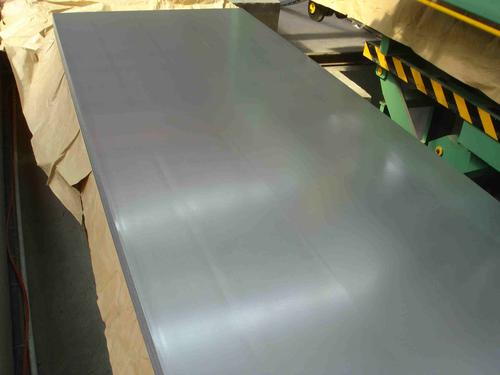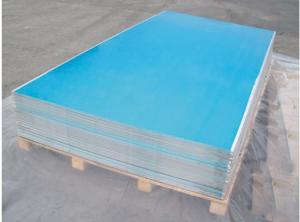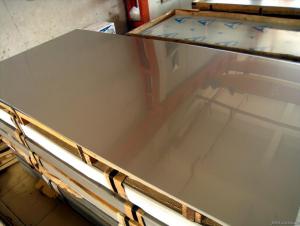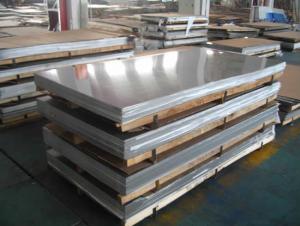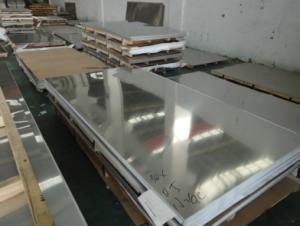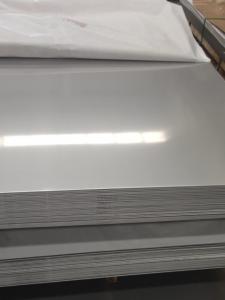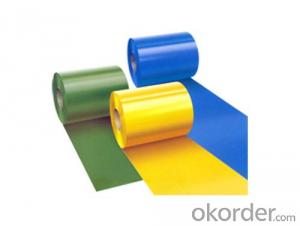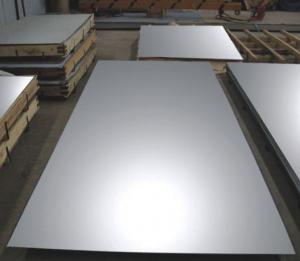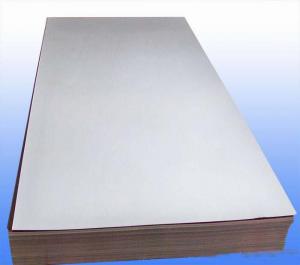Stainless Steel Sheet With Best Quality In Our Warehouse
- Loading Port:
- Tianjin
- Payment Terms:
- TT or LC
- Min Order Qty:
- 4 m.t.
- Supply Capability:
- 5000 m.t./month
OKorder Service Pledge
OKorder Financial Service
You Might Also Like
1.Structure of Product Description
Cold rolled Stainless re many different grades, such as: 200 series, 300 series, 400 series, 900series, etc. The detailed grade are as follows: 201, 202, 301, 304, 316, 410, 420, 430, etc.
The surface is including 2B, BA, Mirror Finish, Checkered, etc.
2. Main features of the product
a. Competitive price
b. Frist-Class Service.
c. Shortest service.
3. Image.
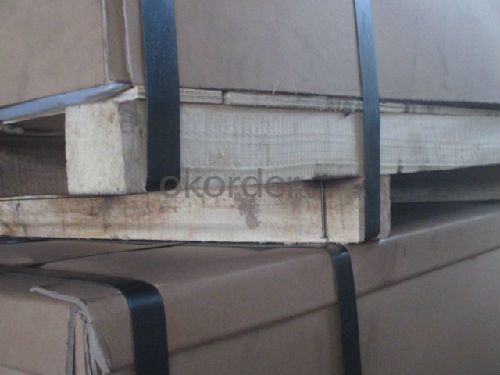
4. Product detailed sizes:
1000mm*2000mm, 1219mm*2438mm,1220mm*2440mm, 1250mm*2500mm,1500mm*3000mm, etc.
5. FAQ:
What is the quality standard?
---Usually our standard is GB3880-2006 or else.
What is the width range?
---It is from 1000mm to 2500mm, etc.
What is the length range?
---It is from 2000mm to 6000mm, etc.
What is the MOQ for your products yet?
---Normally it is around 3 tons/each size.
How many tons did you export in one year?
What is your mainly products?
---Normally they are stainless steel sheet, stainless steel coil, stainless steel checkered sheet, stainless steel mirror finished sheet, color coated stainless steel sheet, etc.
- Q: What is the coefficient of expansion of stainless steel sheets?
- The coefficient of expansion of stainless steel sheets typically ranges from 10.5 to 17.3 x 10^-6 per degree Celsius.
- Q: What are the different types of stainless steel sheets?
- There are several different types of stainless steel sheets, including austenitic, ferritic, martensitic, and duplex stainless steel sheets. Each type has unique properties and is suitable for different applications.
- Q: What are the different types of stainless steel sheet surface coatings available?
- There are several different types of stainless steel sheet surface coatings available, each offering unique properties and benefits. Some of the most common types include: 1. No Coating: Stainless steel sheets without any coating have a natural, smooth surface finish. This type is often used in applications where corrosion resistance is a primary concern. 2. Brushed Finish: This coating creates a distinctive brushed pattern on the stainless steel surface. It provides a decorative appearance while also hiding scratches and fingerprints. 3. Mirror Finish: A mirror coating gives stainless steel sheets a highly reflective surface, similar to a mirror. This type is popular in architectural and decorative applications. 4. Satin Finish: Satin coatings offer a smooth, matte appearance with a low reflectivity. They are frequently used in high-end appliances and architectural elements. 5. Bead Blasted Finish: This coating creates a uniform, textured surface by bombarding the stainless steel with small glass beads. It provides a unique visual effect and can hide surface imperfections. 6. Patterned Finish: Patterned coatings involve embossing or etching designs onto the stainless steel surface. They can create a wide range of patterns and textures, adding aesthetic appeal to various applications. 7. Colored Coatings: Stainless steel sheets can be coated with various colors using processes such as powder coating or electroplating. This allows for customization and adds a decorative element to the material. It is important to consider the specific requirements of your application when selecting a stainless steel sheet surface coating. Factors such as corrosion resistance, durability, aesthetics, and functionality should all be taken into account to ensure the best choice for your needs.
- Q: How are stainless steel sheets produced?
- The production of stainless steel sheets involves a series of manufacturing processes that encompass different stages. To begin with, raw materials like iron ore, coal, and limestone are melted in a blast furnace, which is known as primary steelmaking and results in the creation of molten iron. Next, the molten iron is moved to a basic oxygen furnace (BOF) or electric arc furnace (EAF) where it is combined with scrap steel and other alloys to adjust its chemical composition as desired. The molten mixture then undergoes a refining process to eliminate impurities and attain the desired quality of stainless steel. Once the refining process is finished, the molten stainless steel is cast into large blocks called slabs or billets. These solidified metal blocks are then heated and passed through a series of rollers in a process called hot rolling, which reduces their thickness and shapes them into the desired dimensions. After hot rolling, the stainless steel sheets go through annealing, a process where they are heated to a specific temperature and allowed to cool gradually. Annealing serves to relieve internal stresses and enhance the material's mechanical properties, such as strength and ductility. Following annealing, the stainless steel sheets may undergo further processing such as cold rolling. This process involves passing the sheets through rollers at room temperature to achieve the desired thickness and surface finish. Cold rolling also improves the stainless steel's mechanical properties and enhances its surface quality. Once the sheets have been cold rolled, they are usually coated with a protective film or passivation layer to prevent corrosion. This film acts as a barrier against environmental factors and helps maintain the longevity of the stainless steel sheets. Finally, the stainless steel sheets are cut into the desired sizes and shapes using various cutting techniques like shearing or laser cutting. Additionally, the sheets may undergo additional surface treatments such as polishing or brushing to achieve the desired aesthetic appearance. In conclusion, the production of stainless steel sheets involves melting raw materials, refining the molten metal, casting it into slabs, hot rolling to reduce thickness, annealing to improve properties, cold rolling for further refinement, coating for corrosion resistance, and finally cutting and surface treatment to achieve the desired product.
- Q: What are the standard sizes and thicknesses of stainless steel sheets?
- Stainless steel sheets are utilized in numerous industries and applications due to their wide range of standard sizes and thicknesses. Typically, the standard sizes vary from 4 feet by 8 feet to 5 feet by 10 feet, but customized sizes can also be obtained based on specific needs. In terms of thickness, stainless steel sheets are offered in various standard options. These include 20 gauge (0.036 inches), 18 gauge (0.048 inches), 16 gauge (0.060 inches), 14 gauge (0.075 inches), 12 gauge (0.105 inches), and 10 gauge (0.135 inches). It is important to note that these thicknesses indicate the nominal thickness, and the actual thickness may have slight variations. Additionally, it is worth noting that stainless steel sheets are also available in metric sizes. Common thicknesses in metric sizes range from 0.5 mm to 3 mm. This provides flexibility and compatibility with international standards and specifications. In summary, the standard sizes and thicknesses of stainless steel sheets are determined by industry standards and customer requirements. This ensures their widespread availability and versatility for various applications such as construction, automotive, aerospace, and kitchen equipment manufacturing, among others.
- Q: Can stainless steel sheets be used for architectural wire mesh?
- Architectural wire mesh can indeed be made from stainless steel sheets. This material is highly versatile and widely used in architecture because of its durability, attractive appearance, and resistance to corrosion. By transforming stainless steel into sheets, it becomes easily manipulable and can be woven into wire mesh panels suitable for various architectural purposes, including building facades, interior partitions, sunscreens, and balustrades. The use of stainless steel sheets for architectural wire mesh allows for the creation of intricate and visually appealing designs, while also providing strength, stability, and longevity to the structure. Furthermore, customization options are available for stainless steel wire mesh, including mesh size, wire diameter, and finish, ensuring that it meets the specific requirements of each architectural project.
- Q: Are stainless steel sheets suitable for architectural facades?
- Architectural facades can greatly benefit from the use of stainless steel sheets. Not only are they highly suitable, but they also offer numerous advantages in terms of their aesthetic appeal, durability, and sustainability. Firstly, stainless steel sheets possess an inherent visual appeal that can greatly enhance the overall look of any building. With its sleek and modern appearance, stainless steel can effortlessly elevate the design aesthetic. Furthermore, architects have the freedom to choose from a variety of finishes such as brushed, mirrored, or patterned, allowing them to achieve their desired look and feel. Moreover, stainless steel is highly resistant to corrosion, making it an ideal choice for outdoor applications. It can withstand exposure to harsh weather conditions, pollution, and other environmental factors without deteriorating. This remarkable resistance to corrosion also means that stainless steel requires minimal maintenance, resulting in reduced long-term costs and efforts associated with facade upkeep. In terms of strength and durability, stainless steel sheets excel. They can withstand impact, making them suitable for high-traffic areas or buildings located in regions prone to severe weather events. Additionally, stainless steel is resistant to staining, scratching, and fading, ensuring that the facade remains attractive and intact for an extended period. Sustainability is another significant advantage of stainless steel sheets for architectural facades. As a 100% recyclable material, stainless steel can be reused without losing its properties, making it an environmentally friendly option. Furthermore, its longevity significantly reduces the need for frequent replacements, further contributing to sustainability efforts. In conclusion, stainless steel sheets are an excellent choice for architectural facades due to their aesthetic appeal, corrosion resistance, strength, durability, and sustainability. Regardless of whether they are used in modern or traditional designs, stainless steel can provide a long-lasting and visually pleasing solution for enhancing the exterior of buildings.
- Q: What is the thermal expansion coefficient of stainless steel sheets?
- The thermal expansion coefficient of stainless steel sheets varies depending on the specific grade and composition of the stainless steel. However, in general, stainless steel has a lower thermal expansion coefficient compared to other metals. The coefficient of thermal expansion for stainless steel sheets typically ranges between 10.8 x 10^-6 to 18.0 x 10^-6 per degree Celsius. It is important to note that this coefficient may vary slightly for different types of stainless steel alloys.
- Q: Are stainless steel sheets easy to install?
- Installing stainless steel sheets is relatively easy. They typically come in standard sizes and can be easily tailored to specific dimensions if necessary. Moreover, stainless steel sheets are lightweight and manageable, facilitating a convenient installation process. Furthermore, they often include pre-drilled holes, simplifying attachment to different surfaces. By using the right tools and having a basic understanding of installation techniques, installing stainless steel sheets becomes a straightforward task.
- Q: Can stainless steel sheets be used for elevator cabins?
- Yes, stainless steel sheets can be used for elevator cabins. Stainless steel is a durable and corrosion-resistant material, making it suitable for high-traffic areas like elevator cabins. Additionally, stainless steel has a sleek and modern appearance, making it a popular choice for elevator interiors.
Send your message to us
Stainless Steel Sheet With Best Quality In Our Warehouse
- Loading Port:
- Tianjin
- Payment Terms:
- TT or LC
- Min Order Qty:
- 4 m.t.
- Supply Capability:
- 5000 m.t./month
OKorder Service Pledge
OKorder Financial Service
Similar products
Hot products
Hot Searches
Related keywords



